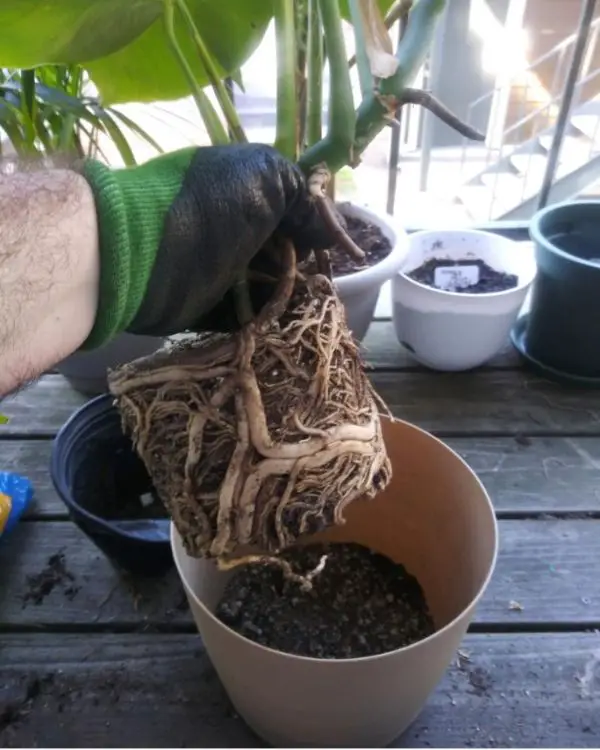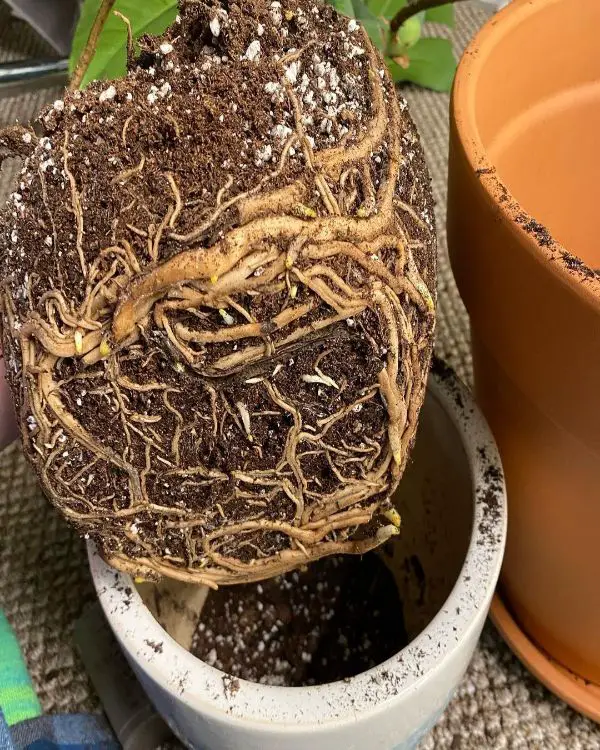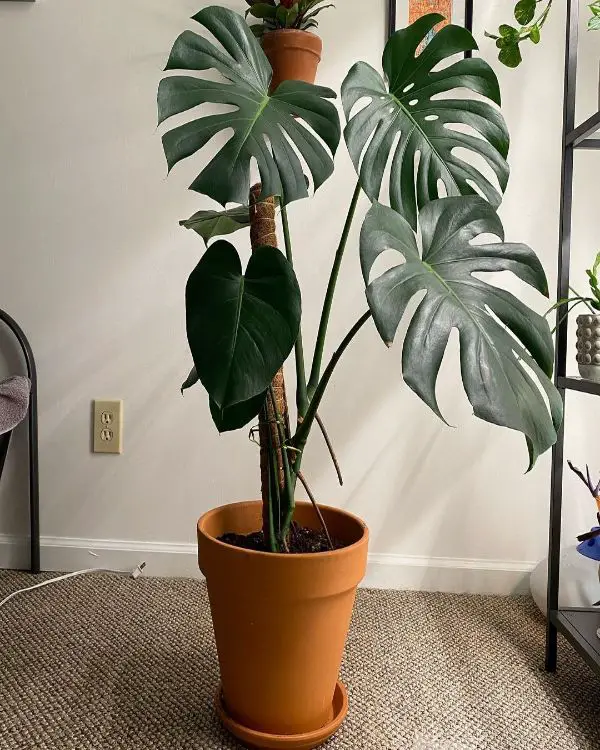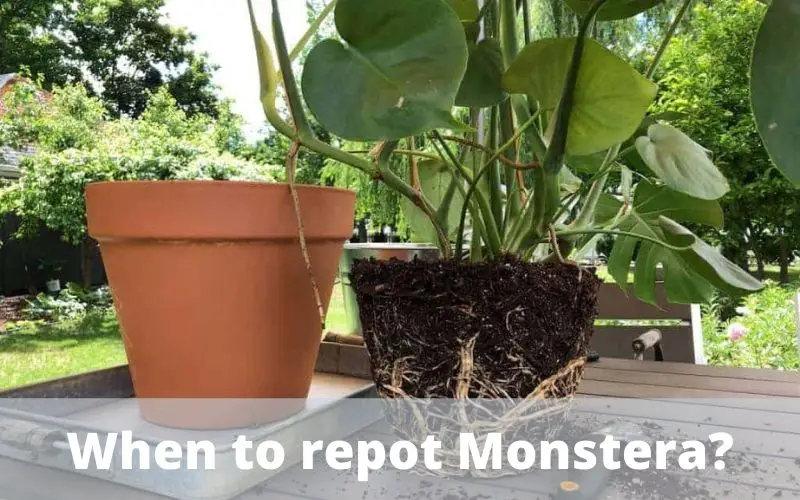Have you ever wondered when and how to repot a Monstera Deliciosa?
Over time, soil in plant pots can become depleted of nutrients and compacted. Repotting Monstera with a fresh potting mix will give the plant the nutrients it needs to thrive and loosen the soil so the roots can spread.
So get out there and give your plant a new home today!
In This Article
When To Repot Monstera?

The best time to repot is in the growing seasons – spring and summer – or when the Swiss Cheese Plant shows any signs listed below.
Roots Growing Out Of The Drainage Holes
This is one of the most obvious signs that your mature plant needs a new home. If you see roots peeking out of the drainage holes, the plant has outgrown its current pot.
Roots Circling The Inside Of The Pot
Another sign that your Monstera needs to be repotted is if you see roots circling inside the pot. This is called rootboundness, which can restrict the plant’s growth and make it more susceptible to pests and diseases.
The Plant Is Top-Heavy And Unstable
If your Monstera plant is starting to look top-heavy and unstable, it may be time to repot it into a larger container with a heavier base, as it will help to prevent the plant from tipping over.
The Plant Is Becoming Stunted Growth
If your tropical plants have slowed down or stopped growing, introduce them to a new home. The plant may have outgrown its current pot, or the soil may be depleted of nutrients.
The Soil Is Drying Out Very Quickly
If the soil in your Monstera plant’s pot is drying out very quickly, it may be a sign that the pot is too small or that the roots have filled it up. Repotting into a larger pot with a fresh potting mix will help to improve drainage and prevent the drying issue. In addition to the above signs, I always replant Monsteras after buying them from a store. Store-bought plants are often grown in small pots with low-quality potting mix. Repotting will give your plant a better chance of thriving in your home.
How To Repot A Monstera Plant

To repot a Monstera plant, you will need the following materials:
- A new pot with plenty of drainage holes that is 2-3 inches wider in diameter than the current one.
- A fresh soil mix.
- A glass of water.
- Gardening gloves (optional).
- Sterilized pruning shears (optional).
I prefer to use terracotta or ceramic pots for my Monstera Adansonii. Terracotta pots are porous, which is beneficial to aerial roots and allows water to flow through. This is good for Monsteras, which need well-aerated soil. Ceramic pots are less porous, but they’re more watertight, preventing root rot from overwatering.
If you are repotting a large Monstera plant, you may also need a pair of hands to help lift the plant. It’s important to be careful not to damage the Monstera Deliciosa or any type you are planting.
To repot your Monstera plant, make sure not to miss any of these simple steps:
Step 1. Prepare your new pot, and fill it with about 1/3 of the fresh potting soil.
Step 2. Gently loosen the root ball of your Monstera from the pot. You can use your fingers or a blunt object to help loosen the roots. A day before replanting, I usually water the Swiss cheese plant to moisten the soil but not make it waterlogged. Doing so makes it easier to pull out the root ball.
Step 3. Place your Monstera in the new pot and fill the remaining potting mix around the roots.
Step 4. Give the moist soil one more drink of water.
Step 5. Let the Monstera thrive in bright, indirect light
See more: Best Soil For Monstera Plant
How Often to Repot Monstera Plants?

Generally speaking, you should repot every 1-2 years. However, there are a few exceptions based on my experiences:
- If your Monstera is still very small, you may not need to repot often. My advice is to repot your Monstera when it has outgrown its current pot by about 2-3 inches.
- If you live in a very hot or dry climate, replant your Monstera more often. The soil will dry out more quickly in these climates, and your plant will need more water and nutrients.
- Low-light conditions can slow down plant growth. Repot the plant more regularly to feed it more nutrients.
Tips For Repotting A Monstera Plant
It is important not to damage the roots when repotting a Monstera plant because this system absorbs water and nutrients from the soil. Once the root ball is harmed, the plant will wilt and lose leaves.
Use a fresh potting mix when repotting. It will not be as effective even if you add new nutrients to the old potting mix. I’m a big fan of recycling old potting mix. Going green and saving green – it’s a win-win! I often recycle it by adding it to my compost bin, creating nutrient-rich compost for my garden.
After repotting, place your Monstera in a location with bright, indirect light. Remember to give plants a drink regularly, but be careful not to overwater and fertilize per month using a fertilizer diluted to half strength.
FAQs
Should I Cut Roots When Repotting Monstera?
Not usually, but if the roots are circling the inside of the pot, growing out of the drainage holes, or making the plant rootbound, you can trim them back slightly. Be sure to use a sharp, clean knife or scissors and make clean cuts at an angle.
What Is The Best Soil Mix For Repotting Monstera?
A good potting mix for Monsteras should be well-draining and airy. You can use a commercial potting mix specifically for houseplants or make your own by mixing equal parts of peat moss, perlite, and vermiculite.
Do Monsteras Like Small Pots Or Big Pots?
Monsteras prefer big pots because they have large root systems and need room to grow and space for a moss pole. As the plant grows, you can gently tie the aerial roots to the moss pole for support.
Conclusion
Repotting is essential to Monstera plant care, but it doesn’t have to be scary. Following the tips above, you can repot your Monstera with confidence and help it thrive in its new home.


